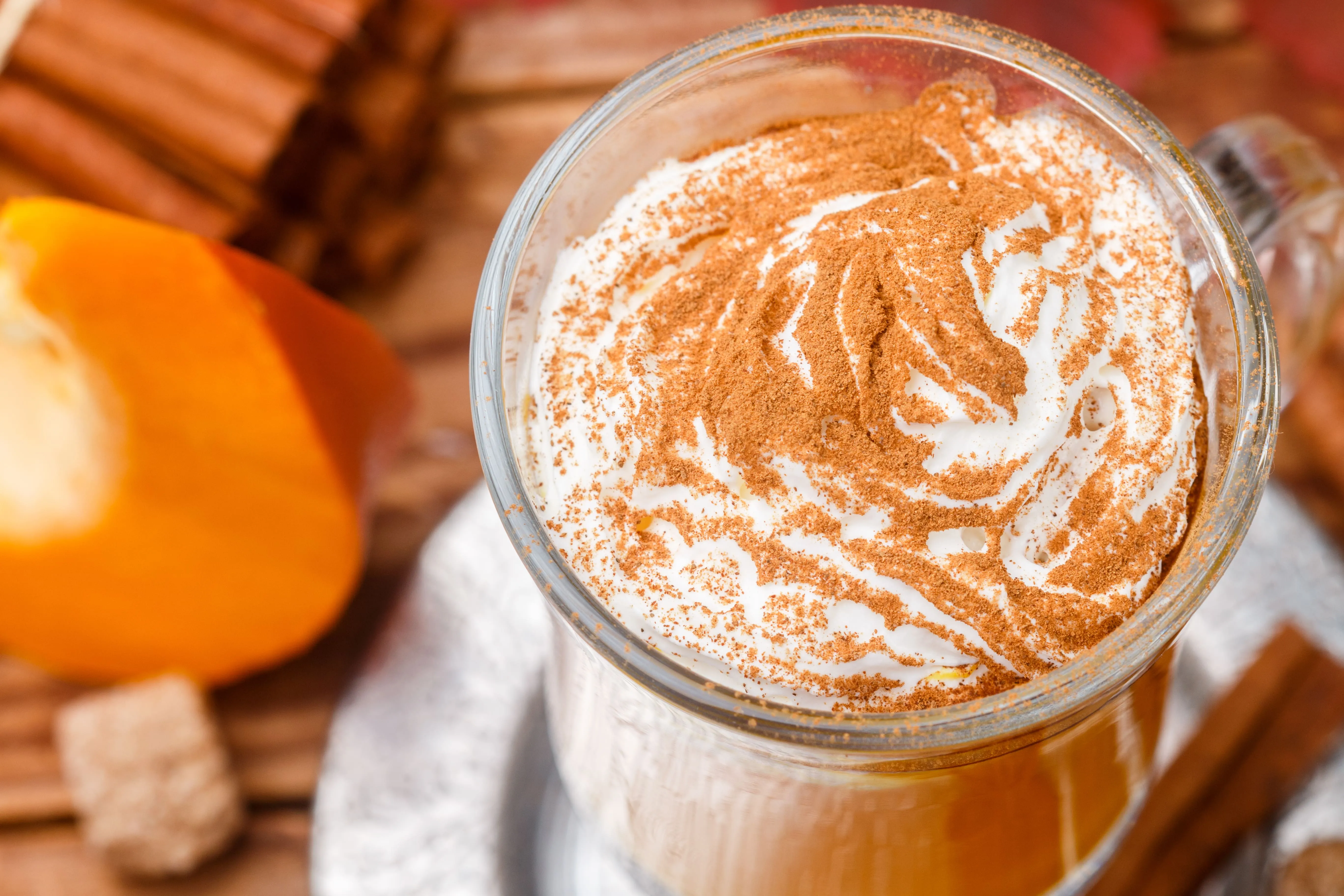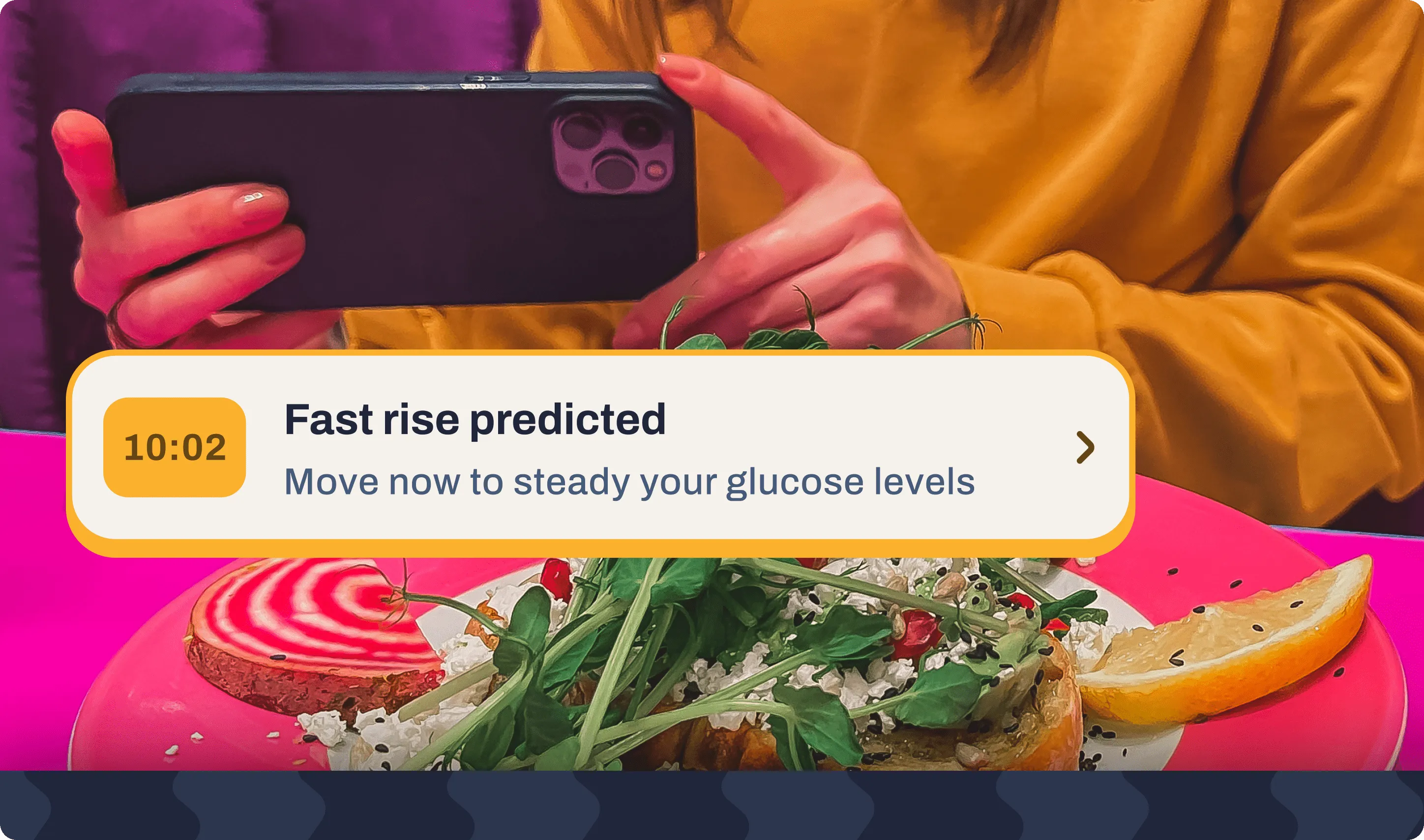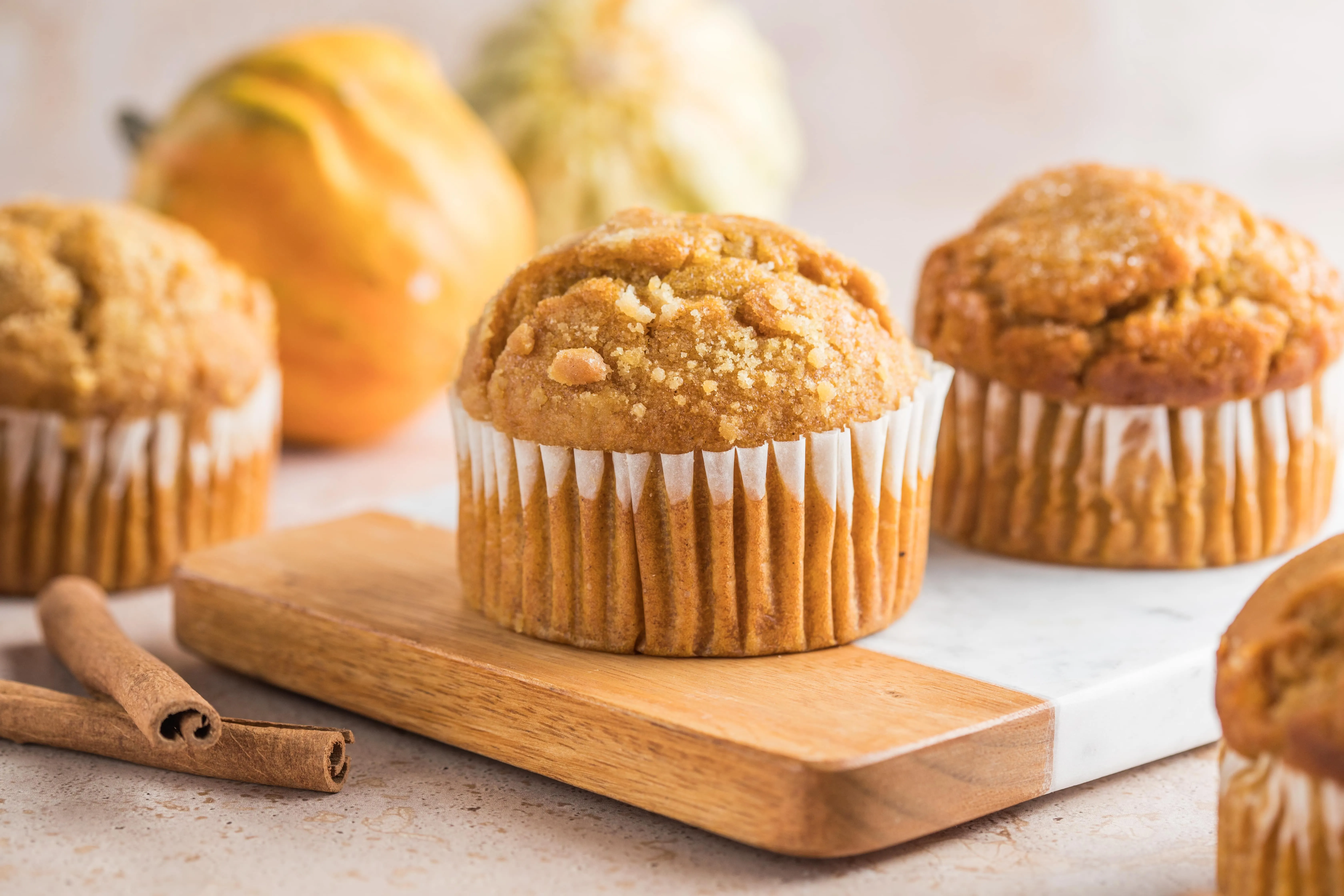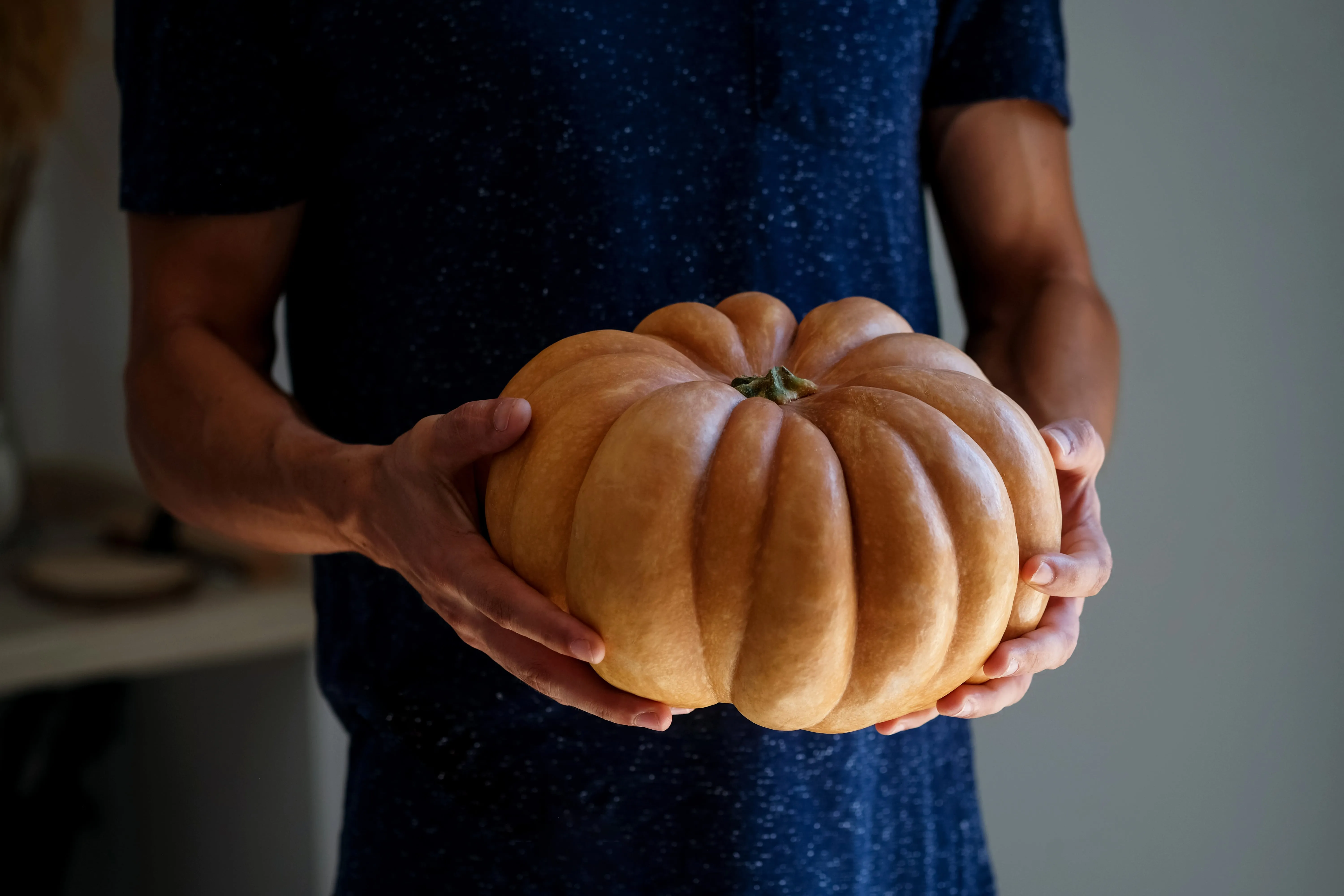Key Takeaways
- Most pumpkin treats in coffee shops contain more sugar than pumpkin, leading to rapid glucose spikes and crashes.
- Liquid sugars and caffeine can amplify glucose and cortisol responses.
- Enjoy fall flavors smarter with fewer syrup pumps, added protein, and DIY pumpkin recipes.
that {{mid-cta}}
From pumpkin pie to pumpkin spice lattes, this bright orange gourd dominates menus. While the health benefits of pumpkin are impressive, most drinks contain more added sugar than actual pumpkin puree.
One cup of pumpkin (cooked) is a powerhouse of nutrients: high in vitamin A, vitamin C, vitamin E, and folate, plus it’s a good source of potassium, magnesium, manganese, and dietary fiber.1 These carotenoids, including beta-carotene, lutein, and zeaxanthin, support eye health, skin health, and the immune system, while helping lower blood pressure and promote heart-healthy function.1
However, just because pumpkin is healthy, it doesn’t mean drinks and baked goods with pumpkin are healthy or natural. These fall favorites are often disguised as sugar bombs. Many coffee shop treats use canned pumpkin or flavored syrup instead of roasted pumpkin or real puree, losing most of the natural antioxidants and carotenoids that protect cells from free radicals and support heart health and cholesterol balance. They contain a fractional amount of pumpkin (or none at all), added sugars, white flour, minimal protein, and fiber, which leads to rapid digestion, glucose spikes, and crashes.
In this article, learn which popular pumpkin treats, such as lattes, muffins, and seasonal snacks, can cause glucose spikes. Make smarter, glucose-friendly swaps to enjoy fall flavors while keeping your energy levels steady and meet your health goals.
The Hidden Metabolic Cost of Coffee Shop Pumpkin Treats

The iconic “PSL,” or Pumpkin Spice Latte from Starbucks, contains 390 calories and 50g of added sugar, which is 140% of the daily recommended limit for men and double the limit for women. While marketed as a cozy seasonal treat, the pumpkin spice latte offers minimal real pumpkin and little nutritional value beyond carbs and fat. Despite small amounts of pumpkin puree, the lack of fiber and high carbohydrates can cause large blood sugar fluctuations. The 14 g of protein offer only minimal support for stabilizing glucose levels.2,3
You might be tempted to choose the Pumpkin & Pepita Loaf at Starbucks, which features pumpkin seeds and whole wheat flour. However, each slice contains 360 calories and 31 grams of sugar, along with just 2 grams of fiber and 6 grams of protein. Though the loaf includes pumpkin seeds, a source of magnesium, zinc, and healthy fats, the benefits are outweighed by high added sugar and refined flour content. Pairing it with protein may help with weight management and reduce glucose swings.4,5
Skinny versions tend to have lower fat and less added sugar. Requesting no whipped topping and using less than the standard four pumps of pumpkin sauce will reduce the added sugar while still providing you with the pumpkin you crave at Starbucks and other coffee shops.
Reducing the sauce to two pumps and omitting whipped cream will cut the added sugar to 32 grams, which is an improvement but still 90% of the recommended amount for men and 130% for women.3
Let’s dive further into why these sugar-loaded pumpkin treats spike glucose.
Why These Treats Spike Glucose

Large amounts of carbohydrates from syrups and sauces can cause glucose spikes, while missing micronutrients like selenium and manganese, which help combat oxidative stress and maintain heart health. Excess added sugar and caffeine can raise blood pressure and increase stress hormone activity. Studies also suggest that consuming large amounts of liquid sugars carries a greater risk of developing metabolic syndrome compared to solid sugars.6,7
Glucose levels tend to peak about 30 minutes after consuming liquid sugars, compared to 60 or 90 minutes with a balanced meal. 8 Interestingly, if you are a fast drinker, glucose and insulin levels peak higher and quicker than those of slower drinkers, even with identical sugar amounts.9
Some people don’t feel as full when consuming liquid calories because they receive fewer hormonal satiety cues (such as GLP-1 or ghrelin suppression), which may lead to overeating or overdrinking.6
Caffeine can amplify the effects of sugar on glucose levels, potentially leading to further increases. People with type 2 diabetes often see larger glucose spikes right after caffeine intake, but long-term coffee drinking is linked to a lower risk of developing type 2 diabetes. The American Diabetes Association recommends unsweetened coffee drinks due to their beneficial effects.10
Additionally, caffeine increases cortisol secretion. Cortisol, a stress hormone, signals the body to release stored glucose, making it available to respond to the stressful situation.11
Consuming high-sugar, caffeine-rich drinks without fiber and protein to stabilize blood glucose levels can lead to a rapid crash. A high spike followed by a plummet can add stress and depleted energy to your morning or afternoon, depending on when you consume high-sugar pumpkin treats.
Consider some of these realistic swaps to satisfy your pumpkin craving this fall and maintain metabolic health.
Metabolic Makeovers: Smarter Pumpkin Picks

Try some of these smart swaps to get your pumpkin fix without the glucose spike this fall. These swaps reduce sugar or increase fiber and protein to help stabilize glucose levels.
Pumpkin Spice Latte Swap:
- Ask for half the amount of syrup pumps, switch to unsweetened almond or oat milk instead of cream, and add protein cold foam.
- Pair your latte with a higher-protein and fiber breakfast, such as scrambled eggs with veggies, to help blunt the glucose spike.
Pumpkin Muffin Swap:
- Consider baking DIY pumpkin protein muffins with almond flour, great northern white beans, and Greek yogurt.
- Use pumpkin puree instead of oil, and top with roasted pumpkin seeds or drizzle with olive oil for extra heart-healthy fats. These swaps can help with weight loss, improve cholesterol, and support overall wellness.
- When searching for recipes, look for those with higher fiber and protein content. Some ingredients that help are eggs, beans, almond flour, Greek yogurt, and using less sugar than the recipe calls for. Usually, you can reduce the sugar by one-third and they still taste great.
Pumpkin Bar Swap:
- Use pumpkin puree, oats, and an unsweetened protein powder for a stable energy boost.
- Avoid pumpkin pie filling with added sugar and use pure canned pumpkin. Add spices like cinnamon or nutmeg and enjoy as a side dish or snack.
The Metabolic Playbook: Navigating Coffee Shops in Fall

Try these practical science-backed strategies:
- Always pair sweet drinks with protein and fiber. If you are going to indulge, lessen the impact on your glucose levels by pairing it with protein- and fiber-rich foods. Egg vegetable bites or Greek yogurt with berries are both good options.
- Downsize portion (tall vs. grande).
- Skip whipped cream, add cinnamon or nutmeg for flavor without sugar.
- Ask the barista how many pumps of syrup the drink requires, and request it half-sweet.
- Try a black coffee and pumpkin spice protein shake as an alternative.
This fall, enjoy pumpkin spice and everything nice with glucose-friendly pumpkin swaps without the excessive sugar. Savor the fall flavors while keeping your energy steady.
The Signos Approach: Test Your Pumpkin Fix

Using Signos’ CGM insights, you can understand how your blood sugar responds to pumpkin foods year-round, whether it’s a pumpkin latte, a cup of pumpkin soup, or a few pumpkin seeds on your salad.
- Use CGM data to see how different café drinks and treats affect your blood sugar levels.
- Compare a full-sugar latte vs. a reduced-sugar or homemade swap.
- Identify which “healthy” treats are stable for your metabolism.
- Experiment with pairing sweet treats with protein and fiber-rich combinations.
Signos empowers you to understand how seasonal foods impact your actual eating and glucose levels.
The Bottom Line
Always consult a registered dietitian before using pumpkin supplements or making major dietary changes, especially if you have concerns about heart disease, cholesterol, or blood pressure. While pumpkin is generally safe, excessive amounts can lead to side effects like digestive upset or excessive carotenoid intake.
With simple swaps and CGM insights from Signos, you can still enjoy the cozy fall flavors you love without the glucose spike and crash. The sweetest part? Staying energized and metabolically balanced all season long.
Learn More With Signos’ Expert Advice
A CGM lets you see how your glucose responds to different types of pumpkin drinks and treats, and helps you improve your overall health. Learn more about glucose levels and tracking on the Signos blog, written by health and nutrition experts.
Topics discussed in this article:
References
- https://fdc.nal.usda.gov/food-details/168449/nutrients
- https://www.starbucks.com/menu/product/418/hot/nutrition
- https://www.heart.org/en/healthy-living/healthy-eating/eat-smart/sugar/how-much-sugar-is-too-much
- https://www.starbucks.com/menu/product/1255/single/nutrition
- https://www.ncbi.nlm.nih.gov/books/NBK459280/
- https://pubmed.ncbi.nlm.nih.gov/31054268/
- https://pubmed.ncbi.nlm.nih.gov/21356139/
- https://pmc.ncbi.nlm.nih.gov/articles/PMC5658251
- https://pmc.ncbi.nlm.nih.gov/articles/PMC8228203/
- https://diabetesjournals.org/care/article/37/2/569/29536/Caffeinated-and-Decaffeinated-Coffee-Consumption
- https://pubmed.ncbi.nlm.nih.gov/16631247/




.svg)










.svg)
.svg)
.svg)
.svg)
.svg)
.svg)
.svg)
